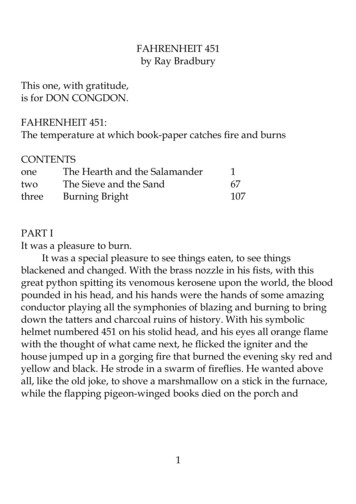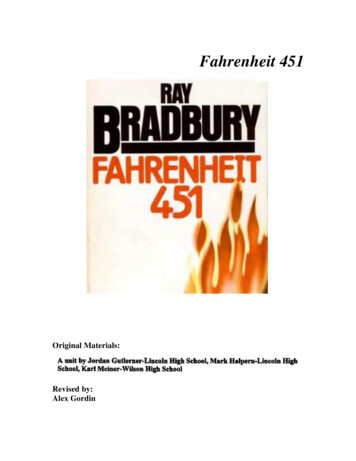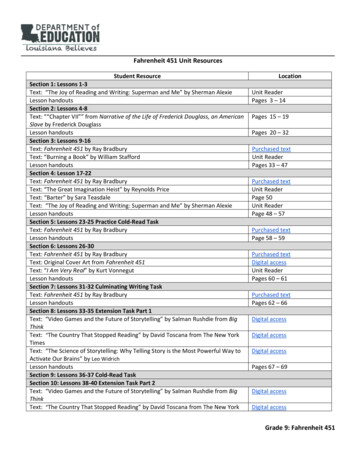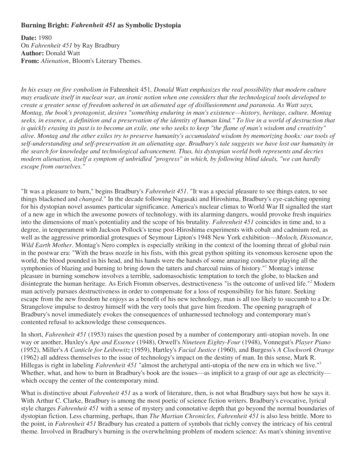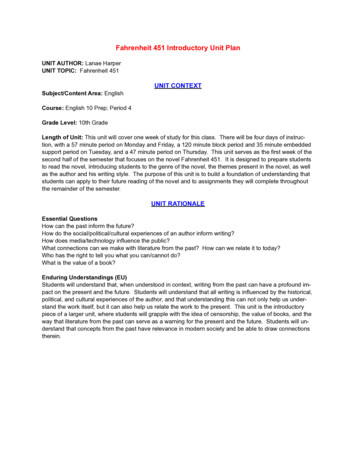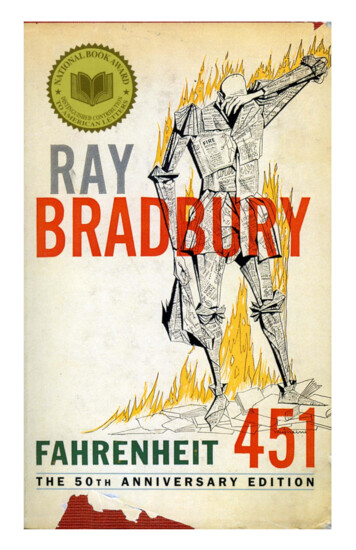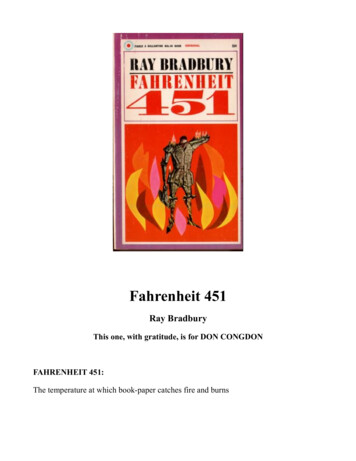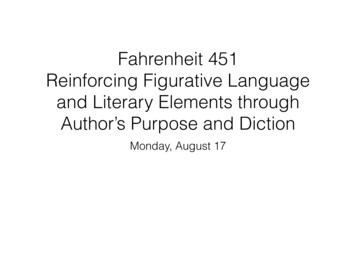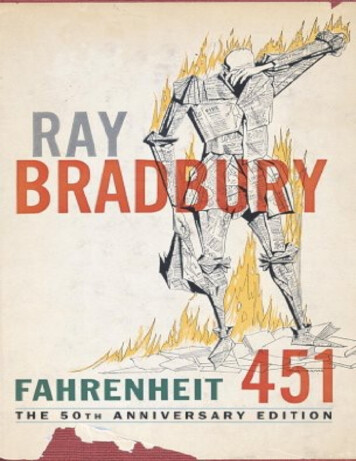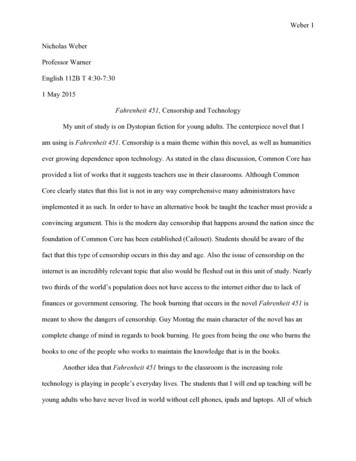
Transcription
A Discourse study ofFahrenheit 451Hegemony, Otherness and Class struggleFredrik MäkiStudentHt 2019Examensarbete för kandidatexamen, 15 hpEngelska
AbstractThis thesis studies Ray Bradbury’s novel Fahrenheit 451 using Critical Discourse Analysis as the primarytool. It argues that the narrative develops through the supporting characters’ actions, and the differentsocietal discourses of hegemony, otherness and class struggle they represent. Basing the analysis onAlthusserian and Gramscian ideas and discussing citizen’s transformation from subjects to individuals,this study concludes that although a subject may be power-less and wary, it is by learning to act throughbeing given information through discourse that personal development occurs.Keywords: Discourse, CDA, hegemony, otherness, interpellation, Ray Bradbury,Fahrenheit 451
Table of contents1. Introduction . 52. Discourse Analysis and societal power structures . 73. Althusser, state, ideology, and subject . 104. Hegemony, the ideologue, mass-man and the other . 125. Characters . 145.1. Captain Beatty . 145.2. Clarisse . 145.3. Faber . 155.4. Granger . 156. Analysis - Mapping characters and discourses . 166.1. Orders of discourse . 166.2. Hegemony . 176.3. Otherness . 226.4. Class-struggle . 267. Conclusion . 288. Works Cited . 31
1. IntroductionThis study explores how secondary characters’ discourses shape the protagonist, GuyMontag, in Ray Bradbury’s 1953 novel Fahrenheit 451. The book presents a “societyintent on the pursuit of happiness” (Myers-Dickinson 79), where happiness stems fromconsumption rather than thought. Family homes are dark or dimly lit at night.Interpersonal social gatherings consist mostly of watching television together, on wallsized screens on 3 or 4 walls of the parlors. In bars and cafés, jokeboxes play the samejokes repeatedly. Roadside adverts are several hundred feet long, to allow viewing fromcars rushing by. The populace live life at break-neck speed without much quiet-time toreflect, to smell old leaves or to taste the rain. Even in bed small earbud-like speakersprovide entertainment, while sleeping pills enable falling asleep quickly, without time tothink. Citizens must not keep books, and much less read them, lest they want to beunhappy. If a citizen finds out that another keeps books, the government must beinformed of the transgression. When the alarm is raised, the fire brigade is sent out totorch the offender’s house, to rid the world of the damaging literary text.State ideology proclaims that knowledge equals unhappiness, and competing ideas arerepressed, controlled, and hunted. Dissidents are not allowed. Nuclear wars have raged,and new wars are on the horizon. The State provides censored and simplifiedinformation to its subjects.The narrative revolves around fireman Montag, whose job it is to burn books instead ofputting out fires, in order to keep the subjects of the state from becoming unhappy byreading literature. Throughout the novel, the reader follows Montag in his meetingswith secondary characters who, on the one hand, wish to keep him from changing, andon the other, to help him on his journey from good subject to enlightened individual.5
Other than Henriette Wien’s 2012 Master’s thesis Claiming mastery of the word, onFahrenheit 451 and 1984, few published works have focused on the power of discourse,but no research has dealt with the discursive function of the secondary characters. Thisessay will, therefore, be able to provide insight into facets that have received littleprevious attention. The study will argue that it is through the different discourses ofhegemony, otherness and class struggle, as represented by secondary characters in theform of teachers and catalysts that the narrative develops. The theoretical framework isbased on Althusserian and Gramscian ideas of ideology, interpellation and hegemony.Themes from Evrim Ersöz Koç’s 2015 article Subject and State: Ideology, StateApparatuses and Interpellation in Fahrenheit 451 and Jo Myers-Dickinson’s 1999doctoral thesis Fashionable Straitjackets and Wooden Men which both discuss theState’s and its representatives’ actions will be expanded upon in the analysis.The analysis focuses on the following central questions: How is discourse used to convince subjects in a totalitarian state of theirfunction as subjects? How does questioning hegemonic principles and discourses lead to free thought? How are subordinate individuals able to rebel against the dominant ideologythrough being situated in different discourses? How are the roles of teachers and catalysts functioning as primary driving-forcesof change?The method of analysis will be based in part on Norman Fairclough’s Critical DiscourseAnalysis and in part on Teun van Dijk’s Critical Discourse Studies with a focus ondiscourse and power relations. Conclusions will be drawn using close reading, studyingboth linguistic features and their place in the sociocultural discourses present in thenarrative.The structure of the essay is separated into several distinct sections. Following theintroduction, there is a section covering the method and critical perspective. Thereafterthe reader finds theoretical background on the concepts used as basis for the analysis ofthe primary text. Following is a short descriptive section on the secondary characters,which serves to give context to the analysis.6
2. Discourse Analysis and societal power structuresA common definition of discourse is “the action or process of communicating thoughtby means of the spoken words” (OED 2013). The act of discourse if thusly intrinsicallylinked to human society. The choice of words and the manner of which these words areuttered decide what content the sender in a communicative event delivers to therecipient. Discourse is, of course, not only one side of these events, as it also mattershow the recipient receives and interprets the information. Furthermore, it is for thisstudy important not to limit one’s understanding of discourse simply as a noun whichdescribes the act of communicating, as it, as a concept encompasses much more.This study employs as its method of analysis ideas found in Norman Fairclough’s 1995book Critical Discourse Analysis, and aspects of power-structures through discourselaid out by Teun van Dijk in his 2008 book Discourse and Power. Although bothauthors have differing views on what to name their methods, the abbreviation CDA hasbeen chosen to represent their concepts in this study. Common for both Fairclough’sand van Dijk’s approaches is that discourse is not only a communicative action, but thatit also implies a social practice and interactions within social, cultural or historicalsituations. Ideology and over-arching societal principles are, too, forms of discourse. Itis, therefore, rarely a good idea to define discourse too narrowly since allcommunicative actions (or texts) function through several aspects simultaneously asthey both constitutes the world and are shaped by the world around them.In order to grasp and understand discourse (here, understood as communicative event)on an interpersonal level, discourse understood as ideology or genres must also beconsidered in the analysis. Fairclough says that all participants in communicativeevents, the producers and the interpreters “draw upon the socially available resources”to them (10). He calls these resources orders of discourse and defines them as thediscoursal facets of the social order which governs what can be expressed and how itcan be expressed. Orders of discourse limit what may be uttered. If the interpersonalcommunicative event takes place, for instance, among doctors, certain discursivepractices govern how and what is uttered.7
In a hospital environment, we would talk of medicine discourse. The same applies in allother situations, be them in a specific institution, or in society as a whole.Discourse is, according to Fairclough, in part the communicative event, in part theaction of communicating, and in part a system that governs what and howcommunication is achieved. van Dijk, meanwhile, explains how discourse is also aninstrument of power. Through societal discourse people’s minds can be controlled, andthose groups with greater influence in society have greater access to public discourse,and subsequently greater access to power. A purpose of CDA, says he, is to explain how“power abuse is enacted, reproduced or legitimized” by those in a position of power(65).The critical component of CDA, which is discussed at length by both Fairclough andvan Dijk, means to uncover domination, to stand on the side of the dominated. Researchbased on CDA should strive for change by providing evidence for illegitimate use ofdiscursive actions by the dominant groups. Building on Cultural Marxist theoriesdeveloped by Gramsci and Althusser, but rejecting concepts of passive subjects andseeing ideology not through a Marxist lens, van Dijk and Fairclough both argue thattheir socially committed perspectives provide insights into communication that otherresearch might not find.To analyze discursive events and the dimensions of power in Fahrenheit 451, theselected analytical tools are based on van Dijk’s ideas of sociolinguistic analysis andFairclough’s three-dimensionality. The former entails beginning with paying closeattention to word choices and how it varies depending on “different social positions,relations or dimensions” (41). However, as van Dijk points to, it is necessary tocombine this linguistic approach with aspects of social science to reach a completeanalysis of the entire situation as an analysis of the words themselves is not enough toreach a complete understanding of the communicative event.8
This view is shared by Fairclough, as his critical approach includes the notion that allcommunication includes three aspects at work simultaneously, namely: “(i) a languagetext, spoken or written, (ii) discourse practice (text production and text interpretation),(iii) sociocultural practice” (97). It is therefore imperative, when employingFairclough’s approach to include in the analysis:Linguistic description of the language text, interpretation of therelationship between the (productive and interpretative)discursive processes and the text, and explanation of therelationship between the discursive processes and the socialprocesses. (Fairclough 97)The communicative event is understood as a function of the discursive practices that areused in its interpretation, and it shapes those same practices, depending on thesociocultural genres the discourse is part of. The event, the setting, and the broadercultural sphere are all thus linked and cannot be separated in the analysis.9
3. Althusser, state, ideology, and subjectIn the 1971 article Ideology and Ideological State Apparatuses, French philosopherLouis Althusser expands on Marxist theory concerning the state’s dominating ideologyand class-struggle. He states that the classical Marxist understanding of there being“State power” and “State apparatus” (207) is insufficient, and that the latter should bedivided into the Repressive and the Ideological State Apparatus. Where RSA containsgovernment institutions such as the police and the courts, ISA is a plurality of entitiessuch as the educational ISA, communications ISA, and cultural ISA.What separates the two State apparatuses, Althusser says, is that while RSA functionsprimarily through violence, ISAs function “massively and predominantly by ideology”(208). Together, the two State apparatuses form the basis of the dominating ideology,allowing the ruling class to exercise power over the citizens. The RSAs punish thosewho misbehave, and the ISAs create the ruling ideology which should be lived by all ina particular society. Althusser claims they are inseparable, that the one cannot functionwithout the other (209). Furthermore, RSAs are always unified under a centralizedcommand, be that the government or a representative thereof, but ISAs are instead“secured, usually in contradictory forms, by the ruling ideology” (208) since their veryform is one of theory and thought, rather than a formalized institution.The fact that ISAs are diverse institutions of ideology, not concrete governmentfunctions, leads, according to Althusser, to ISAs being a site of class-struggle:[ ]because the resistance of the exploited classes is able tofund means and occasions to express itself there, either by theutilization of their contradictions, or by conquering combatpositions in them in struggle (Althusser 209)It is much easier for those not in power to challenge the ruling set of ideas in those Stateapparatuses that are not unified and controlled by the rulers. It is, therefore, vital for theruling ideology to be applied to the ISAs. Through such acts as “physical force”“administrative commands” and “open and tacit censorship” (210), via RSAs, the rulingclass can control how the ISAs function.10
The inverse is also of crucial importance. Althusser makes clear that the ruling ideologydoes not become that by itself. State power, and thus the very function of the RSA, mustcome from the realization of ideology. When it supersedes what formerly was, those oldnotions are pushed aside, and the new ideology becomes the ruling set of ideas. ISAs,therefore, enables the RSAs, while RSAs enable the upholding of the ruling ideology inISAs.Through the ISAs, ideology creates, or “interpellates individuals as subjects” (216). Asubject is someone who is accepted by the ideology as more than an individual. Thegood subjects live according to the dominant ideology, function in society, work “allright by themselves,” and “are inserted into practices governed by the rituals of theISAs” (219). Althusser’s theory on interpellated subjects also includes the notion that inbeing a good subject, one “submits to a higher authority, and is therefore stripped of allfreedom except that of freely accepting his submission” (219).11
4. Hegemony, the ideologue, mass-man and the otherWhile traditionally, the concept of hegemony has meant “domination of one sort oranother” (Bates 352), Antonio Gramsci’s understanding takes it further. The Italianphilosopher active in the early 20th century reconstructed Marxist ideas on economicsand transformed it, Bates says, to hegemony being a political form of leadership basedon consent from those who are led. The ruling class secures their right to lead “by thediffusion and popularization of the world view” (352).This cultural leadership is obtained and ingrained in the citizens of the state throughwhat can best be described as an alternative understanding of Althusser’s Stateapparatuses. Gramsci, however, prefers to call them “Political society” and “Civilsociety”(353), where the former “exercise ‘direct dominion’ and the latter is a“marketplaces of ideas, where intellectuals enter as ‘salesmen’ of contending cultures”(353). While there exist competing ideas in civil society, it is through the power of thosethinkers who belong to the ruling class that the consent of the people is secured.The two societies are interdependent, as hegemony cannot be achieved by the one on itsown. Any society, and especially a totalitarian, needs both the force of the politicalsociety and the civil society’s ability to convince the masses through propaganda. If,however, the prevailing ideology is successfully employed through the cultural sphere,Gramsci claims that “society enters a period of relative tranquility, in which hegemonyrather than dictatorship is the prevailing form of rule” (355).Furthermore, Gramsci’s theory includes that for hegemony, and subsequent tranquilityin the state to be achieved, there must first exist a stable state that teaches the massesabout the ruling ideology. Humans do not become independent (or subordinate to theruling ideology for that matter) by themselves. There is a need for intellectuals to leadthe struggle.12
These intellectuals, which Myers-Dickinson calls the “founder/lawgiver” (26) or the“ideologue” (38), are the ones ultimately responsible for the creation and maintenanceof the totalitarian state. She says that for the masses to heed the calling of the ideologue,there first must be a period of unease and displeasure of the previous regime.Therefore, dystopian societies “are seldom initiated during times of [ ] prosperity”(25). The masses will follow new leaders when they have been sufficiently convinced ofthe new regime’s ideology as the right way forward, away from the old. Through theactions of charismatic and unshakably confident (27) ideologues who can proclaim anew world order and convince the populace of, not only the advantages of the newsystem but also of the wrongs of the previous, a new society develops.People, Myers-Dickinson says, are by themselves often in need of guidance from thosewith greater knowledge. If this indoctrination is successful, the people will be “fiercelyloyal to the mandated ideology of their State” (25), to the point of seeing liberty as lessof an “individual choice” (26), but instead “total submission of the self to the collective”(26). She calls this person “mass man” (25). It is a citizen, or using Althusser’sterminology, a subject. It is someone who is so integrated into the hegemonic ideologythat individual freedom is cast aside, and the citizen becomes a mere “human lemming”(38) who loses free thought.Those who do not follow along with the ideas put forth by the ruling class, those whosubscribe to Gramsci’s notion of “contending cultures” (Bates 353) risk being cast out,becoming the “socially designated Other” (Myers-Dickinson 32) or Althusser’s badsubject. While the true believer, the mass man is a part of society, and thus a citizen or agood subject, the Other is someone whom the ruling class must rid the (ideological)world of. Thus, an “’us’ vs ‘them’ binary system” (63) is created, which allows those inpower to teach the good subjects that what the Other is doing is terrible, and how to actto stay functional. Finally, society may also create networks of spies to watch over andreport on erroneous behavior, to maintain mass conformity (71).13
5. CharactersHaving now devoted quite a bit of space to method and background, which to the readermight appear as part of a sociology-paper, what follows below is an introduction to thebook’s secondary characters. These four are deemed the most important to thenarrative’s development, as they all function as catalysts rather than bystanders.5.1. Captain BeattyCaptain Beatty, Montag’s boss, the fire chief, is undeniably the main antagonist of thenarrative. He is a “disciplinary force that restores wayward gone firemen to ‘normalcy’”(Pundir 176). He sees that Montag is starting to question the hegemonic discourses setforth by the state, and he uses his extensive knowledge of both the historical and thecontemporary society to bring Montag back into the fold. By quoting literature andexplaining the firemen’s rules from a historical perspective his goal is to sterilize the“caught in-between” (Pundir 177) fireman. Michael LaBrie goes further in stating thatCaptain Beatty represents “a leader amongst the spoiled, superficial phonies” (26). Hepossesses a wealth of knowledge, which makes him an ideologue at work for the Stateideology.5.2. ClarisseClarisse McClellan is the first catalyst; whose free-thinking personality makes Montagquestion the world he lives in. She is, according to herself, “seventeen and insane”(Bradbury 5). She is forced to see a psychiatrist because of her being “antisocial” (26)and “abnormal” (27). As her name suggests, her “effect on Montag is illuminating forsure” (Koç 123). Her family is equally misfit. Clarisse tells Montag about how her unclehas been arrested multiple times for doing things such as driving at moderate speed onthe highway, and for being a “pedestrian” (7). The McClellan family spends itsevenings having meaningful conversations, and Clarisse tells Montag how she likes tostudy people, sometimes riding the subway all day, listening to other people talk. Herconclusion, which Montag at first has a difficult time accepting, is that “People don’ttalk about anything” (28).14
From their first encounter, Clarisse starts Montag off on his journey of self-discovery byasking questions. Rafeeq McGiveron’s analysis states that Montag sees Clarisse as amirror that reflects his insecurities and inexperience at him, but that, in actuality, it isMontag himself who “throws away the poorly fitting mask after Clarisse shows [ ] thetruth underneath” (64). Koç elaborates by saying that it is because of Clarisse providinga reflection that Montag realizes his subjection to the ruling discourses.5.3. FaberFaber, meanwhile, a college professor who does not believe the book as an entity iswhat is essential, but rather what it contains, how it “stitched the patches of the universetogether” (Bradbury 79) into something that can be understood. Faber says he does not“talk things”, but rather “the meaning of things” (71). Montag comes to Faber’s housebecause he needs someone who will listen to him. Faber is a teacher who lets Montagknow that he can, and does, think for himself. LaBrie explains how Faber is “portrayedin a cleverly placed juxtaposition in which Montag is displayed as a changing agent in asociety full of travesties” (32). By not only telling truths to Montag, as Beatty does butinstead allowing Montag to live, to feel what it is to think freely and to act per one’swish, he teaches the fireman about freedom.5.4. GrangerGranger is the final teacher helping Montag transform into a person with real individualthought. He, too, is an academic who hides in the woods outside the city with hiscontingent of out-of-work college professors who all lost their employment when theliberal arts institutions were closed due to insufficient applicants. This group of avidreaders has taken it upon themselves to preserve the contents of literature in their minds,having developed a method of photographically remembering texts. The people inGranger’s network are agents of counter-power (van Dijk) working to slowly overthrowthe present ruling-class, in order to recreate a society that once was.15
6. Analysis - Mapping characters and discourses6.1. Orders of discourseThis essay aims to study how discourses inside the novel, rather than those in the realworld in the 1950s, affect the protagonist, it is thus of essence to establish whichdiscourses are to be analyzed.It is, according to Fairclough, up to the researcher to carefully choose which discoursesto study, and to do so consistently to make sure the results are viable. MarianneJørgensen & Louise Phillips, on the other hand, explain how it is wise to see discoursesas an analytical tool which is used to create “a framework for study” rather thansomething concrete which exists in reality (143). They say it is merely “a particular wayof representing the world (143).As the goal is to explore the impact discourses have on subjects of a totalitarian state, itis beneficial first to touch upon the underlying orders of discourse which are central, butperhaps not overtly discussed in the analyses of those discourses represented by thesecondary characters. All analyses will, however, need to have a base in theseunderlying ideas.Fahrenheit 451 is a dystopian novel; therefore, the critical underlying discourses mustbe those of dystopian literature and the totalitarian state. For an authoritarian state,eliminating the will of the populace and the thought of the individual is of the utmostimportance. This then creates dystopia, where free will and individual thought are notmerely frowned upon, but outright banned. History is erased and replaced with a versionthat validates the leader(s). The dystopian state demands total allegiance of the citizens,and those who will not are eliminated. Here, Althusser’s interpellation is seen, whenmedia outlets and other ISAs “spew[.] forth a continual flow of banalities designed tonumb the mind and, thus, remove the threat of independent critical thought” (MyersDickinson 20).16
With the underlying orders of discourse, i.e dystopia and totalitarianism, it is possible topick out which over-arching themes will be analyzed and discussed. As has beenestablished earlier in the essay, Fairclough calls these themes orders of discourse. Sincespace (and time) is limited, the analysis will be restricted to Hegemony, Otherness, andClass-struggle. Within these orders of discourse, effort will be made to show how thefour secondary characters employ different aspects of these discourses andcorresponding social processes to teach the protagonist and help (or hinder) him on hisjourney.6.2. HegemonyHegemony, according to Gramsci’s theory is a cooperation between the rulers and thosewho are governed. In Althusser’s view, it is a question of power emanating from theState, controlling the subjects. In the world of Fahrenheit 451, Hegemony can beconsidered to be both. On the one hand, as Captain Beatty so eloquently puts it, theState was not responsible for a world where thinking was frowned upon. He says that“[t]here was no dictum, no declaration, no censorship, to start with” (55). The publicwanted less thinking and more easily digested entertainment. They did not want toworry, and the cultural ISAs obliged.On the other hand, hegemony as State power is shown when Montag’s wife and herfriends are discussing politics, and a recent election. Here, the conversation does notconcern actual policy or ideology, but rather the candidates’ physical appearance.Because of the public’s aversion to processing difficult topics, the State has arranged itso that whoever wins the election is the one who is deemed the most good-looking.Montag’s wife exclaims “you just don’t go running a little short man like that against atall man” (93), as, apparently, a shorter candidate does not exude as much trust assomeone who is taller. This communicative event does awaken the question of whetherthe State practices hegemony partly through sham-elections meant to fool the populaceinto believing there is some form of democracy left.17
Furthermore, the protagonist is positioned as a spectator in the novel’s openingparagraph. The firehose is a “great python spitting its venomous kerosene upon theworld” (1), thus acting as the agent. When everything around him is burning, Montag“grinned the fierce grin” (2), showing he has learnt to take pleasure in seeing booksbeing destroyed. According to Koç, this proves that Montag is “a passive subjectconstructed by the dominant ideology” (122) instead of a free-thinking individual.Montag, says Koç, is an “interpellated subject” (122), who takes pride in his occupation,and he feels closely connected to all other firefighters. Thus, by understanding thatinterpellation is finished and successful in the case of Montag, the reader is thenallowed to follow along on his journey.Yet another view of hegemony in the novel is through Beatty’s interactions withMontag. The first time the Captain’s hegemonic role appears is when they discuss a jobwhere an older man was found in possession of many books. Montag asks whathappened to the man and says that he was not insane. To this Beatty replies “Any man’sinsane who thinks he can fool the Government and us” (31). Insanity is not only inreading literature but also in attempting to break the law. The man was thereforebrought to an asylum. The State eliminates all dissidents in its midst to keep control.The same becomes apparent when an older woman refuses to leave her home, which issoon to be burnt under the law. Beatty tells her “You know the law” and asks, “Where’syour common sense?” (35). Common sense, then, is to accept that books are bad, andthat the government only wants what is best for its citizens.When Montag later becomes unwell and stays at home, Beatty visits him and lectureshim on why the country developed as it did. In this entire section, Beatty’s rhetoricincludes relating facts instead of the state-mandated history found in the firemen’srulebooks. Employing Gramsci’s ideas on hegemony as cooperation between those inpower and those without, it is possible to understand Beatty’s reasoning for choosingnot to use State-mandated information. To ensure that the recipient, Montag, receives areal understanding of the firemen’s job, he must learn the truth. Beatty feels thatdelivering the ideas of the ruling ideo
This study explores how secondary characters' discourses shape the protagonist, Guy Montag, in Ray Bradbury's 1953 novel Fahrenheit 451. The book presents a "society intent on the pursuit of happiness" (Myers-Dickinson 79), where happiness stems from consumption rather than thought. Family homes are dark or dimly lit at night.
